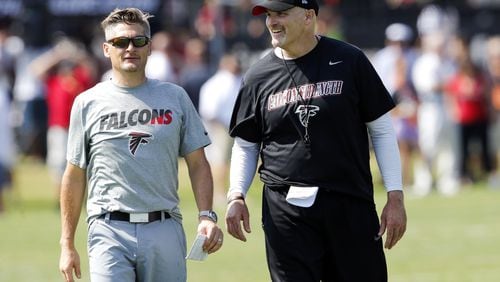The last media look inside the Falcons’ draft nerve center was a few years back, but is still relevant.
There was an 80-inch television on the wall facing general manager Thomas Dimitroff’s desk. He said he, Scott Pioli and others often watched tape of a player on that screen.
There was a 60-inch touch-screen draft board, on which Dimitroff can access scouting reports and contract information on every player on every team, as well as depth charts for every team.
The long wall in Dimitroff’s office had an old-school draft board. Player names, dimensions and bios are on magnets and hang in order of ranking. There are separate columns for 11 positions.
While it’s not exactly a top-100 ranking of prospects, Dimitroff noted to AJC columnist Jeff Schultz, that he could tell who was still available during the draft just by looking at the top of the board.
The defending NFC champion Falcons, who have the 31st pick in the first round, are doing their final shuffling of the board for the draft, which is scheduled for April 27-29 in Philadelphia.
“Atlanta is sitting in an interesting situation down at the bottom of the first round,” NFL Network analyst Bucky Brooks said. “A lot of what is going to be available to them will depend upon what others decide to do at defensive end and outside linebacker.”
The Falcons don’t believe that they have many holes and will have the opportunity to select the best player available. However, much of the pre-draft discussion has been about addressing the need for another pass rusher or a right guard to replace veteran Chris Chester, who retired.
“I officially believe the best player available is the way to go,” said Daniel Jeremiah, a former NFL scout and NFL Network draft analyst. “Now, to me, what you do, then, in that case, if you want to match up your need with best player available, is move around on the board, trade out of there if you want to get more value, or trade up if you want to get somebody that fits that need.”
Dimitroff has traded up to fill needs before to land left tackle Sam Baker in 2008, wide receiver Julio Jones in 2011 and cornerback Desmond Trufant in 2013.
The Falcons could be plotting another move up in the draft. They worked out two defensive ends, Tennessee’s Derek Barnett and UCLA’s Takkarist McKinley, who project to be long gone before their first-round pick.
“(Teams must) make sure (they’re) watching the value and the need together,” said Jeremiah, who was a scout with Ravens, Browns and Eagles. “I think you get in big trouble when you end up passing on great players at other positions to take good players at a position that you need right now. I mean, you can go back and look, there’s examples every single year.”
Last season, Miami selected tackle Laremy Tunsil with the 13th pick.
“They didn’t have a glaring need at the tackle position, but they had a player they felt like could be a premier left tackle in the NFL,” Jeremiah said. “He kind of fell into their lap. Instead of going to a different position of need, they took what I thought was one of the best players in the NFL Draft at tremendous value.”
There is a rule in scouting and drafting circles: “You don’t pass up great players for good players,” said Brooks, who played five seasons in the NFL. “You take the best available player at your selection, then you try to find a way to make it work.”
The Falcons have six picks in the draft. They don’t have their sixth-round pick, which went to Tennessee in the Andy Levitre trade. The Falcons are expected to address their pass rush at some juncture in the draft.
“Because of the scheme, what they currently have with Vic Beasley, you would like to think they need more of a traditional base defensive end that has pass-rush ability,” Brooks said. “When you look at the board, what could be available to them at the bottom of the first round, you think maybe (Michigan defensive end) Taco Charlton.”
Outside of the first round, the Falcons could select Ohio defensive end Tarell Basham, Florida Atlantic’s Trey Hendrickson or Texas A&M’s Daeshon Hall, Brooks said.
“If they’re looking for a guy that is more in the mold of Vic Beasley, kind of an outside linebacker that has the ability to maybe rush on third downs, (Wisconsin defensive end) T.J. Watt would have an opportunity to be in the conversation, (Alabama linebacker) Tim Williams, (Alabama linebacker) Ryan Anderson and (defensive end) Derek Rivers from Youngstown State. There (are) some intriguing possibilities.
“It’s a matter of what does Dan Quinn wants to do with his defense and how does he want to compliment his No. 1 rusher in Vic Beasley.”
It’s not a good year for the Falcons to try to find a starting offensive lineman in the draft.
“I talked to an offensive line coach this week who said this is the worst offensive line class that he’s seen in 15 years,” Jeremiah said. “I started in ’03, I go back to there and it’s not a good group of offensive linemen.”
Alabama’s Cam Robinson, Wisconsin’s Ryan Ramczyk, Utah’s Garett Bolles, Indiana’s Dan Feeney and Western Kentucky’s Forrest Lamp are considered the top offensive linemen in the draft.
The Falcons have heavily scouted Lamp and worked out Bolles in Salt Lake City.
“The offensive line depth in this draft probably isn’t as good as it has been,” said Kevin Colbert, Pittsburgh’s vice president and general manager. “Traditionally, interior lineman, for whatever reason, guards and centers — there’s never a great number.”
About the Author







